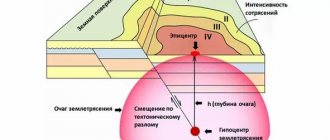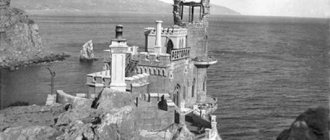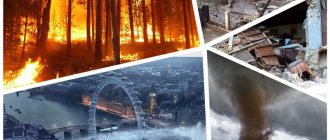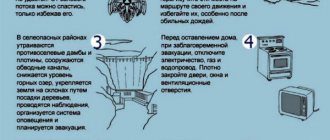What is a tsunami?
Translated from Japanese, the word " tsunami " means a wave in the bay. In other words, these are large waves that are formed as a result of a strong impact on the water column in the ocean or sea.
The main difference between this natural phenomenon and ordinary high waves lies precisely in the nature of their origin. If ordinary waves form only on the surface of the water, then a tsunami covers its entire thickness. The size of the waves depends on the volume of the reservoir.
The average wave height is 10-40 meters. Tsunamis spread at speeds of up to 900 km/h. They can take on various forms. Often these are several waves that roll onto the coastline with a certain period of time - from 3 minutes to 2 hours. Sometimes the elements represent alternating ebbs and flows.
tsunami wave
Interesting fact : the maximum wave height that was recorded during the tsunami was more than 500 meters.
Do not confuse a tsunami and a typhoon, since these are two completely different natural phenomena. The only thing they have in common is the speed of spread. Typhoons occur only on the surface of the water and are caused by strong winds. Tsunamis are more powerful and are characterized by several damaging factors.
How to understand that trouble is near?
Unfortunately, humanity has not yet learned to accurately predict the time of a tsunami. Typically, once a state of emergency is declared by the authorities, you have a maximum of 5-15 minutes to try to escape. But there are a number of signs by which you can determine that a disaster is imminent:
- Animals and birds begin to behave strangely for no particular reason: they show signs of anxiety and run away from the coastline. Surprisingly, it is the representatives of the fauna who most accurately anticipate the approaching wave. So, if you suddenly notice how a dog playing happily by the water has broken off its leash and is running away at unprecedented speed, you should be vigilant;
- The water suddenly moved away from the shore to a noticeable distance. If the strange behavior of animals can be ignored, then the exposed bottom is the clearest signal of impending danger;
- Small earthquake. As a rule, the main impact occurs at the depths of the ocean, and only “echoes” (slight trembling of the earth, movement of standing objects) reach the shore.
- Unusual behavior of water and objects in it: the sudden formation of currents and funnels, a ship that has sharply turned off course or a log circling in a strange way.
Causes
The causes of a tsunami can be divided into the most common and probable. In most cases, this phenomenon occurs under the influence of several factors simultaneously. A tsunami occurs if the factor activating it is of sufficient strength.
Interesting: Why are plants planted in spring? Description, photo and video
The most common factors:
- underwater earthquake;
- landslides;
- eruption.
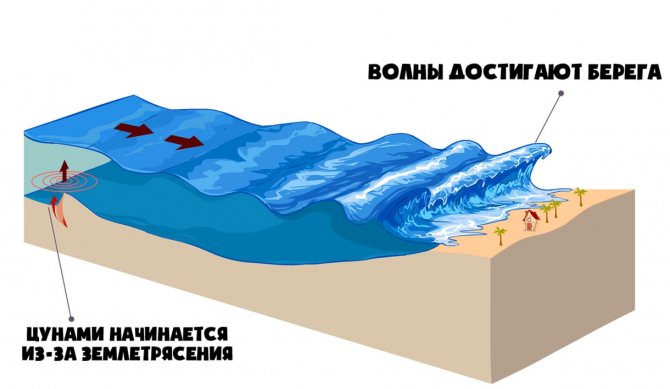
An earthquake causes a tsunami in 85% of cases. In this case, changes occur at the bottom of the reservoir, namely displacement. As a result, part of the bottom goes down, and the other part goes up. This displacement causes the water to oscillate in the vertical direction. It strives to find its original position - the average level, so waves are formed.
A tsunami does not occur after every earthquake. Only tremors whose foci are located shallowly are capable of causing strong waves. The difficulty is that experts still cannot accurately determine tsunamigenic earthquakes.
Landslides cause tsunamis in 7% of cases , although previously this factor was greatly underestimated. They are formed in combination with earthquakes, or rather, landslides often occur due to strong tremors. In this case, massive rocks collapse, often together with ice.
Volcanic eruptions account for 5% of total tsunamis . They create the same effect as tremors. Moreover, during an eruption, water can fill the cavities that arise during the collapse of the crater walls. This phenomenon allows the tsunami wave to actively grow in length.
Other possible reasons:
- meteorite fall;
- strong wind;
- human activity.
If a large enough meteorite falls into a body of water, it can create a wave. But it takes on a circular shape and rapidly loses power without turning into a tsunami. A real disaster can only occur if a cosmic body falls close to the shore - at a distance of 10-20 km.
As mentioned earlier, the wind creates waves up to 21 meters in height, but they cannot be called a tsunami. a meteotsunami can form .
Human activity can also negatively affect natural conditions. At the same time, they talk about the occurrence of artificial tsunamis. This includes various tests in the form of atomic explosions, activation of hydrogen bombs, etc., which is why they are prohibited in some international treaties.
Interesting: Habitat: what it is, what it affects, diversity, photos and videos
Causes of tsunami
The causes of tsunamis are most often natural, but there are also man-made and artificial, i.e. caused by human activity.
- Underwater earthquakes . According to statistics, 85% of tsunamis occur due to underwater earthquakes. In the contact zones of the lithospheric plates of the earth's crust, they collide and shift relative to each other. This leads to a change in the topography of the seabed: one part of it rises, and the other goes down. The earthquake resonates with the vibrations of the sea wave, causing the sea water to rise to a considerable height. Not all underwater earthquakes lead to tsunamis, but only those that have an epicenter located close to the surface of the seabed. By determining the power of an earthquake, scientists can predict with a high degree of probability the possibility of a tsunami. But forecasts can be wrong.
- Landslides . Earthquakes on land and water can trigger large landslides. At the same time, huge blocks of coastal and underground rocks and glaciers collapse. They fly at high speed from a height of about 1 km. This is especially dangerous in bays, bays, and rivers, when collapsed rocks create a wave. It reaches the opposite shore, destroying human buildings, taking lives. There are places in the world that are prone to this kind of regular tsunami: Alaska, China, Indonesia.
- Volcanic eruptions . In the world's oceans there are active underwater volcanoes, from which lava flows periodically pour out. Waves are formed as a result of a volcanic explosion or after a vent is filled with a large volume of sea water. Lava flows from coastal volcanoes can also provoke strong disturbances in water masses.
- The fall of cosmic bodies . A tsunami can be caused by a larger meteorite falling into the depths of the sea 10-20 km from the coast. The diameter of the cosmic body should be several hundred meters.
- Man-made disasters . Typically they occur due to human negligence or natural disasters. This could be an explosion at a nuclear power plant located on the sea coast.
- Artificial factors . Deep-sea nuclear tests and explosions of several hydrogen bombs simultaneously along one line near the shore can lead to disturbances in the water column. A huge artificial wave will arise that will cover nearby islands and the coasts of continents.
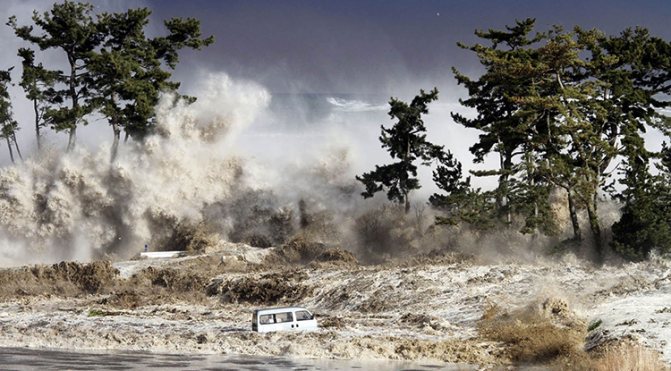
Classification
Tsunamis are classified according to several criteria, such as the causes of occurrence, the intensity of the phenomenon, and the number of people affected. Depending on their origin, tsunamis are divided into 4 types:
- caused by underwater earthquakes;
- caused by volcanic eruptions;
- caused by landslides;
- caused by coastal earthquakes.
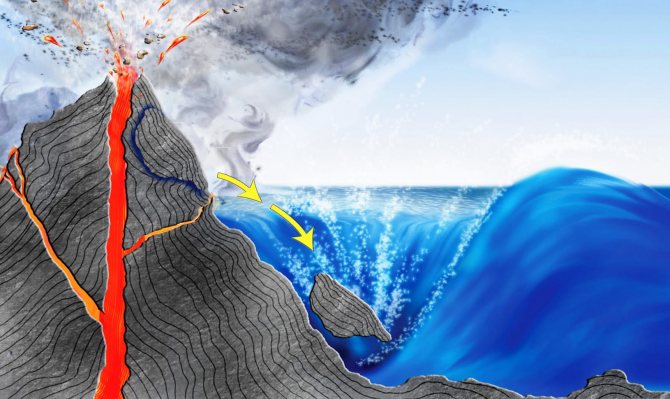
Based on the intensity of the waves, their height and strength, the following types of elements are distinguished, distinguishing them with a point system:
- 1 point – such waves can be noticed only with the help of special instruments. Considered non-hazardous.
- 2 points – the coastline is partially flooded.
- 3 points – waves of medium intensity reach 2 meters. They pose a danger to small vessels and structures on the shore of a reservoir.
- 4 points – intense wave height up to 3 meters. Such a tsunami can wash small ships ashore and then wash them into the ocean. Structures along the shoreline are suffering moderate levels of damage.
- 5 points – especially strong waves 8-23 meters in height. The extent of destruction depends on the proximity of objects to the coastline. Even heavy ships are washed ashore.
- 6 points – a phenomenon of this, most powerful type, is considered a natural disaster. As a result, a large number of people suffer, the coastline is flooded, and structures are almost completely destroyed.
Tsunami classification according to the number of victims is presented in 5 groups:
- 1 – no casualties;
- 2 – up to 50;
- 3 – from 50 to 100;
- 4 – from 100 to 1000;
- 5 – more than 1000.
Interesting fact : one of the most powerful tsunamis occurred in the Indian Ocean (2004) as a result of an underwater earthquake. The territories of 11 countries received damage. The waves reached and exceeded 30 meters. The element moved at very high speed - it only took a couple of hours to cover the distance from one shore of the ocean to the other.
Harbingers
Tsunami belongs to natural phenomena that arise suddenly and spread dynamically. But if you are attentive and observant, you can notice some signals that foreshadow a natural disaster. These include the following signs:
- Unusual behavior of animals trying to quickly leave the coastal zone. Aquatic inhabitants try to get to the depths.
- The rumble of tremors.
- An unexpected high or low tide, as a result of which water flows several kilometers towards the reservoir.
- In winter, you can hear the sounds of cracking ice, and also see unusually drifting ice sheets in places where such phenomena are not typical.
Interesting: Why is Mafia Island called that?
An underwater earthquake or one that occurred on land near a body of water should already alert you. The same applies to a sudden low tide that does not occur according to the “schedule”.
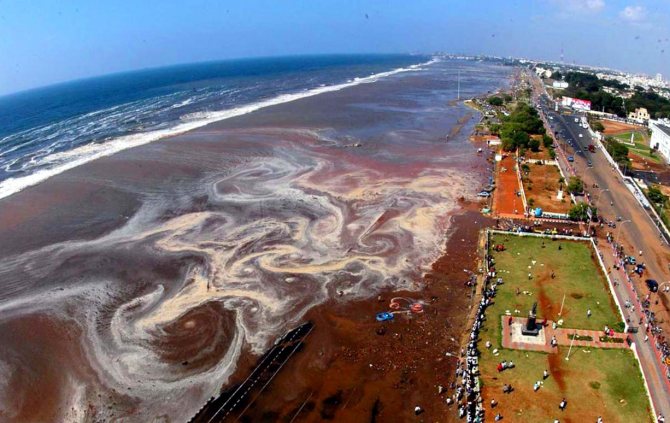
Low tide
Interesting fact : before hitting land, the first wave of a tsunami moves far from the coast. Moreover, the more the ocean bottom opens, the more powerful the water flow will be. The wave will return a few minutes after low tide.
Sometimes the destructive waves of a tsunami are not yet visible, but they can be heard - from a distance they resemble peals of thunder.
Safety rules for tsunami threats
Comments are off
Tsunami
- this is a dangerous natural phenomenon, which is sea waves that arise mainly as a result of the upward or downward displacement of extended sections of the seabed during underwater and coastal earthquakes
.
Tsunami-hazardous areas of our country are the Kuril Islands, Kamchatka, Sakhalin, and the Pacific coast. Having formed in any place, a tsunami can spread at high speed (up to 1000 km/h) over several thousand kilometers, while the height of the tsunami in the area of origin is from 0.1 to 5 meters. When reaching shallow water, the wave height increases sharply, reaching a height of 10 to 50 meters. Huge masses of water washed ashore lead to flooding of the area, destruction of buildings and structures, power and communication lines, roads, bridges, piers, as well as the death of people and animals. An air shock wave propagates in front of the water shaft. It acts similarly to a blast wave, destroying buildings and structures.
The tsunami wave may not be the only one. Very often this is a series of waves that roll onto the shore at intervals of 1 hour or more. The possible scale of destruction is determined by the range of the tsunami: weak (1-2 points); average (3 points); strong (4 points); destructive (5 points).
Signs of a tsunami:
A natural warning signal of the possibility of a tsunami is an earthquake. Before a tsunami begins, as a rule, the water recedes far from the coast, exposing the seabed for hundreds of meters and even several kilometers. This low tide can last from a few minutes to half an hour.
The movement of the waves can be accompanied by thunderous sounds that are heard before the approach of the tsunami waves. Sometimes, before a tsunami wave, the coast is flooded with a water “carpet”. Cracks may appear in the ice cover off the coast. A sign of an approaching natural disaster may be a change in the usual behavior of animals, which sense dangers in advance and tend to move to higher places.
If there is a tsunami threat:
1. Quickly leave the coast and take refuge in places whose height above sea level is at least 30 -40 meters. At higher elevations, you should climb up the slope, and not along the valleys of rivers and streams. If there is no hill nearby, you need to move away from the coast at a distance of at least 2 - 3 km.
2. In the event of an earthquake close to the shore, the arrival time of the tsunami wave can be several minutes, so you should act according to a pre-thought-out plan in order to make the most efficient use of precious time - in this case, your life depends on the speed of response.
3. While in the building, quickly leave it without creating panic or blocking the doors. After leaving the room, take shelter on a hill.
4. During the transition to a safe place, provide assistance to children, the sick and the elderly.
After the arrival of the first wave:
1. Help the victims, provide them with first aid. If possible, call an ambulance or medical professional.
2. Wait for the alarm to clear. Return to your original location after making sure that there have been no high waves at sea for two to three hours.
3. When entering the house, check its strength and the safety of windows and doors. Make sure there are no cracks in the walls and ceilings, and no erosion of the foundations. Carefully check for gas leaks in the premises and the condition of the electrical lighting.
4. Be prepared for the arrival of the next waves - they can be stronger and more destructive than the first wave.
Source: www.65.mchs.gov.ru
12.10.2014 21:09
Consequences
A tsunami is a truly destructive natural phenomenon, the damage from which is determined by various factors: height, speed, direction of the wave, etc. The consequences that cause a tsunami are divided into primary and secondary.
Primary consequences:
- It's not just the waves that pose a threat, but also the strong air flow they create. Under their influence, weak coastal structures are destroyed.
- Affected people.
- Flooding of agricultural areas (crop destruction), washing out the foundations of residential and industrial buildings.
- Destruction of coastal cliffs and ports.
- Vehicles being washed out to sea and ships washed ashore.
Given the fact that most coastal areas are densely populated for various reasons (including to attract tourists), tsunamis cause enormous damage to these areas. After each flood and the accompanying consequences, these areas have to be rebuilt.
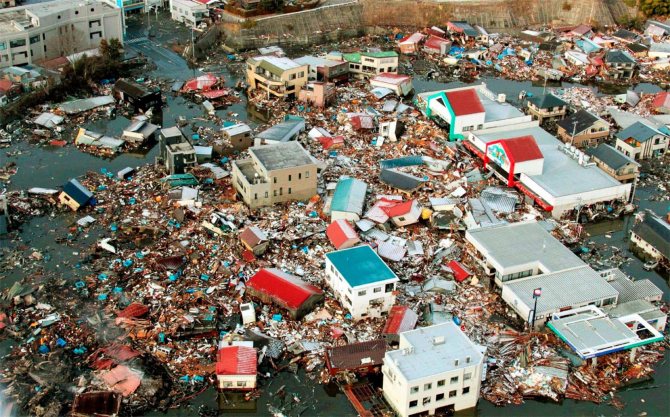
Consequences of the tsunami
Secondary causes are directly related to the destruction of industrial facilities. In this case we are talking about the consequences of a man-made nature. For example, tsunamis damage the integrity of ships, oil storage facilities, and processing plants for various products. They can also cause accidents at nuclear power plants. All such emergencies entail consequences in the form of various environmental pollution and fires.
Interesting: The first giant mammals - description, photos and videos
Why is a tsunami not scary in the sea?
Tsunamis pose a danger only to coastal areas and bays. In the middle of the sea or ocean they are not dangerous for ships. This feature is explained by the nature and mechanism of the spread of the elements.
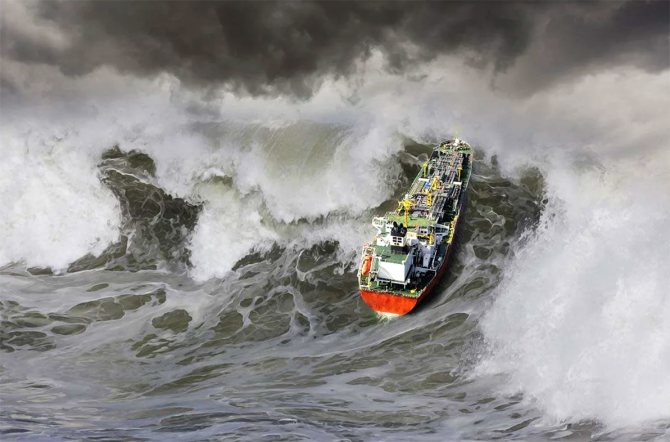
Ship on high waves
The fact is that in the open sea the height of tsunami waves does not exceed several meters. The elements have a huge space at their disposal, measured in kilometers. Thus, the strength and power of the waves is “distributed” along the entire length of the front. Near the shore, the tsunami, on the contrary, intensifies and reaches maximum power.
Notification system
When it becomes known that an earthquake has occurred in the Pacific Ocean, the Pacific Center transmits the relevant information to all tsunami warning services. It becomes immediately known about the coordinates and strength of the earthquake, as well as the likelihood of a tsunami and its estimated strength.
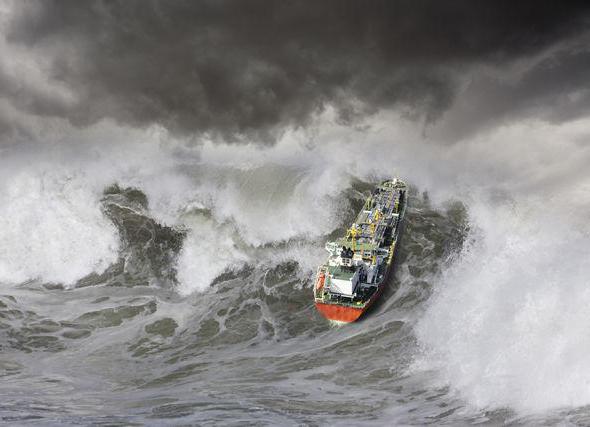
The first people to know about an approaching tsunami are sea level monitoring stations. They are located in close proximity to the epicenter of the earthquake. When confirmation of the formation of waves of abnormal height is received, residents of the areas that they may affect receive a warning, and all operational services are put on alert. At these moments, it is especially important to know the rules of behavior during a tsunami point by point.
When it becomes apparent that there is a real threat of high wave propagation, an alarm is issued. All operational services receive relevant messages. In the Kamchatka Territory this happens using a special system called OKSION. This modern system operates in fourteen of the most tsunami-prone settlements in Kamchatka. Operational services immediately convey information to the population. For this purpose, there is a warning system, in particular, radio broadcast points, sirens, and loudspeakers briefly list, point by point, the rules of behavior during a tsunami.
What to do if a tsunami occurs?
The main thing to do after receiving a warning about an approaching tsunami is to react as quickly as possible, following some rules. First of all, you need to do the following:
- do not panic;
- objectively assess the situation;
- leave the building after turning off the electricity and gas;
- leave the coastline and do not approach the shore closer than 3-4 km (higher areas are preferable).
Situations are possible when there are precursors of a tsunami (earthquakes, low tides, etc.), but no official notification is received. In this case, it is better to act proactively.
People who live in potentially hazardous areas should make a disaster plan in advance and stick to it. It is necessary to warn others about the impending disaster.
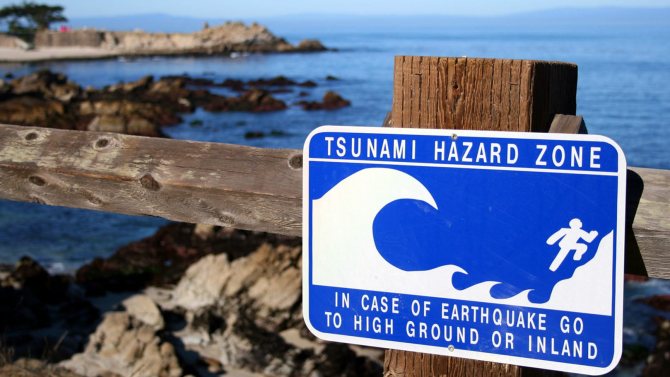
Tsunami Warning
If time and current conditions allow, it is recommended to take documents, other valuables, water, dry clothes and pack it all in a waterproof bag. You can wait out the waves at a height of at least 40 m.
A tsunami sometimes strikes quite suddenly. In this case, there may simply not be enough time for the above actions. Finding yourself on the shore in the very epicenter of a natural phenomenon, you should find the strongest possible structure or tree and grab onto it tightly (so as not to end up in the water column).
Interesting: Insects in amber - how they get there, description, photos and videos
If the waves overtake you in a building, you need to go to the top floor and find shelter. Suitable options are rooms without windows, doorways, corners.
Those who find themselves in the water are advised to take the following actions:
- get rid of shoes and heavy clothing;
- group;
- find a large, reliable object and cling to it.
It is important not to return to shore immediately after the first wave. Tsunamis often arrive in the form of second, third and subsequent waves with even greater force. As soon as a message appears that the threat has passed, a check of the surviving buildings begins.
What to do after a tsunami
When the tsunami has receded, you cannot return to your home or hotel or go to the shore. The first wave may be followed by a second and third, and they may be stronger. Therefore, you need to stay away from the coast, or even better, try to go deeper into the island or mainland so that the second and third stronger waves do not overtake you. Only when the authorities give a signal that the waves have ended can you return to the house.
When you enter a house, if there is anything left of it, you need to beware of objects that could fall on your head. You may also get an electric shock. Therefore, you can enter the room only after making sure that everything is in order.
Protection measures
In order to minimize the consequences of the tsunami, a system of protective measures has been developed:
- Specialists constantly monitor seismic activity and make short-term/long-term forecasts.
- Timely notification of the population using sirens, television and radio broadcasting.
- A ban on the construction of buildings along dangerous coastlines or the construction of high-strength buildings.
- Construction of hydraulic structures (breakwaters, dams, jetties).
- Strengthening the coastline by planting trees.
- Sending ships to the high seas.
- Drawing up and disseminating tsunami action plans to local residents, as well as regular drills.
- Preliminary preparation of evacuation means and places equipped with everything necessary.
- Fire prevention measures.
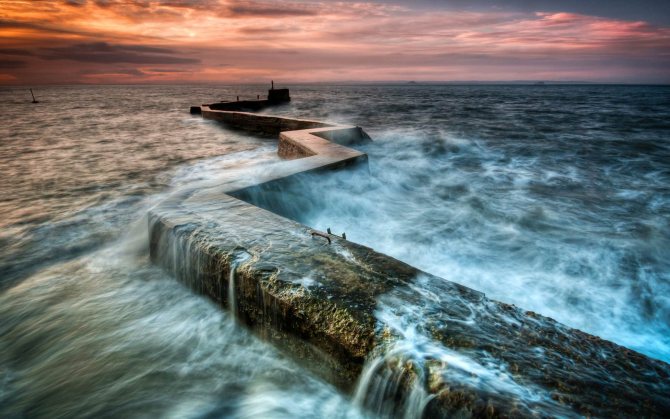
Breakwaters
Tsunami forecasting
Specialists are working on long-term and short-term forecasts. Long-term forecasting involves assessing risks for certain territories. What is the probability of a tsunami, wave speed and height, etc.
A short-term or operational forecast allows you to know about the occurrence of a tsunami when it has actually occurred. Seismologists receive data about tremors and, based on this information, decide whether a tsunami is possible and, if so, how dangerous it is. The problem is that disasters occur for other reasons.
Modern instruments and scientific advances make it possible to more accurately predict tsunamis. For example, deep-sea DART devices.
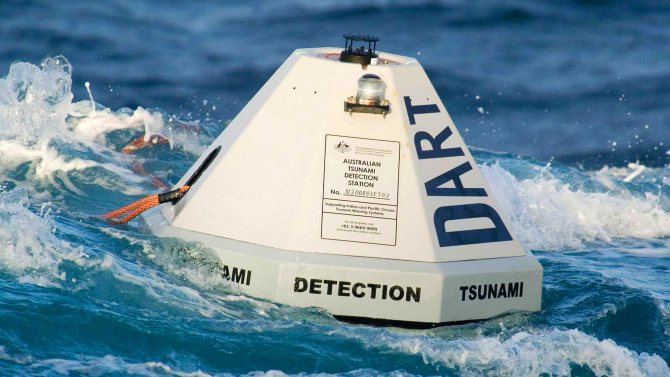
Tsunami recognition device
Where do tsunamis most often occur?
High seismic activity is observed in the Pacific Ocean. For populated islands and territories with access to water in this zone, the highest danger threshold has been established. This applies to underwater earthquakes. If a tsunami occurs as a result of landslides, then it poses a threat to any coastline.
Interesting fact : according to the results of studies of various regions, increased attention is paid to Alaska, northern California, and South America.
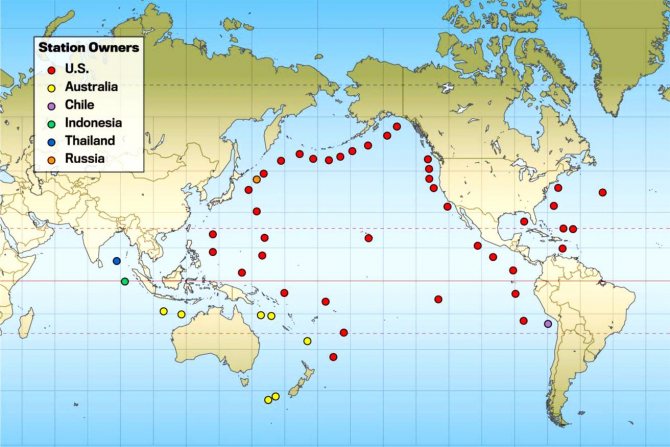
Tsunami zoning
What to do in case of a tsunami
Tsunamis are huge sea waves that most often arise as a result of a strong underwater earthquake when a rapid change in the bottom topography occurs.
It acts on the water like a huge piston, raising or lowering large masses of water, which, scattering in all directions, form waves. Less commonly, a tsunami occurs as a result of the eruption of underwater or island volcanoes, the collapse of large masses of earth rocks into water, and underwater landslides. In the open ocean, tsunami waves travel at speeds of up to 1000 kilometers per hour. But there they are very flat, since the wavelength (the distance between the crests) reaches 100-300 kilometers, and the height from the base to the top is only a few meters, and therefore are not dangerous for navigation. When waves enter shallow water, near the coastline, their speed sharply decreases to 50-100 kilometers per hour, and their height increases. Near the coast, a tsunami can reach several tens of meters. The highest waves, up to 30-40 meters, form along steep shores, in wedge-shaped bays and at capes protruding far into the ocean. Coastal areas with closed bays are less dangerous.
The Tsunami Warning System (TWS) in the Pacific Ocean includes 25 countries, including Russia, whose coastal areas are affected by tsunamis.
The Far East Tsunami Warning Service is interregional and consists of three regional services: Kamchatka, Sakhalin regions and Primorsky Territory. In the Kamchatka region, tsunami warnings are carried out by the tsunami station of the Kamchatka Territorial Administration for Hydrometeorology and Environmental Monitoring and the seismic station of the Institute of Earth Physics of the Russian Academy of Sciences.
The Pacific Tsunami Warning Center (PTWC) is located in Honolulu, Hawaii, USA.
When a strong earthquake occurs in the Pacific Ocean, the Pacific Center informs all members of the SOC about the time, coordinates and strength of the earthquake. The first information about a tsunami comes from sea level monitoring stations located in the immediate vicinity of the earthquake's epicenter. If confirmation of the formation of waves is received, then in the event of the approach of a destructive tsunami and to bring operational services to a state of readiness, the TCPC transmits a warning.
The tsunami station, after analyzing this information and if there is a real threat of a tsunami to Kamchatka, announces an alarm.
If a strong nearby earthquake occurs off the coast of Kamchatka and a possible threat of a tsunami, the seismic station announces an alarm and transmits it according to the warning scheme. The tsunami station distributes this message throughout the region, as well as beyond its borders, calculates tsunami parameters (wave height and arrival time), analyzes information about the observed wave heights received from hydrometeorological stations, and transmits the alarm. The tsunami station also transmits information about wave heights on the peninsula to the TCPC, based on which the Center makes an assessment of the tsunami danger for other areas of the Pacific Ocean.
- Signs of a tsunami threat: a strong earthquake with a magnitude of 6 or more - when vibrations of the earth's surface make it difficult to walk, buildings shake, pendant lamps sway strongly, dishes fall and break, objects fall from shelves, furniture may move. Strong vibrations last 20 seconds or more;
- a sudden rapid withdrawal of water from the shore over a considerable distance and drying out of the bottom, while the sound of the surf ceases (don’t even think about going down to the water to check this!). The further the sea recedes, the higher the tsunami waves can be;
- rapid decrease in sea level at high tide or increase at low tide;
- unusual drift of ice and other floating objects, formation of cracks in fast ice;
- huge reverse faults at the edges of stationary ice and reefs, the formation of crowds and currents.
What to do if there is a tsunami threat
- If you are out of earshot of a warning or in inaccessible coastal areas, then if you detect signs of a threat, you should remember that tsunami waves can reach the shore 15-20 minutes after the earthquake begins. During this time, it is necessary to immediately take protective measures: it is necessary to move away from the coast inland to a hill where the altitude above sea level is 30-40 meters. If you are on the shore of an enclosed bay, then this height should be at least 5 meters; it is necessary to move away from the coast up the slopes, and not along the river valleys, since the tsunami penetrates the farthest inland along the rivers;
- if there is no hill nearby, you need to move away from the coast at least 2-3 kilometers.
Tsunami Study
Specialists from Japan, Russia, and the USA are most actively studying tsunamis, but in general, research is being conducted all over the world. The pioneers in this field in the Russian Federation were the academies of S. Solovyov and Y. Israel. They contributed to the creation of a warning system for an impending tsunami in the Far East.
Interesting: Earth: structure, description, atmosphere, orbit, surface, photos and videos
Studying this phenomenon is a complex task. First of all, experts strive to speed up the process of tsunami recognition, warning the population, and also expand the list of disaster harbingers.
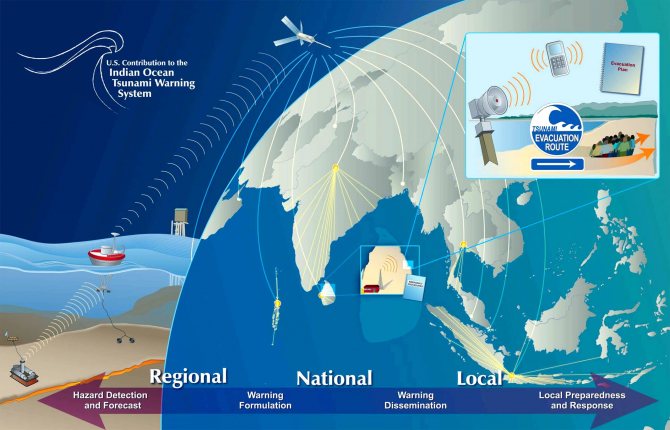
Notification system
The most famous tsunamis in history
The most famous were natural phenomena that caused enormous damage. Among them, the following tsunamis are worth noting:
Coast of the Indian Ocean . The seabed fractured in 2004, after which waves of 30 meters in height were formed. The coasts of Thailand, India, Sri Lanka, and East Africa were affected.
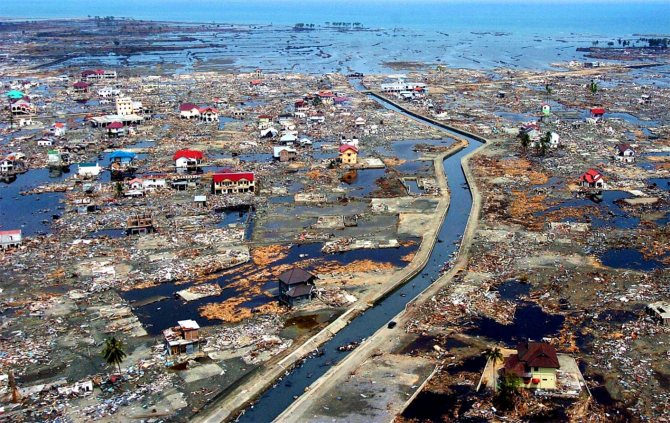
Indian Ocean Tsunami (2004)
Northeastern part of Japan . A tsunami hit the coast in 2011. Miyagi Prefecture was hit the hardest. The height of the waves reached 40 m. Material damage amounted to several hundred billion dollars. There were also accidents at nuclear power plants.
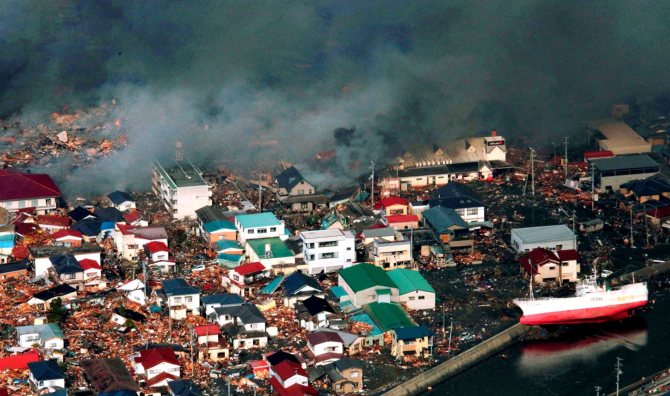
Tsunami in Japan (2011)
Alaska, Lituya Fjord . In 1958 there was an earthquake and landslide. A huge mass of ice and soil fell onto the bay from a distance of 1 km. A powerful wave arose, which quickly reached the opposite shore, reaching more than 500 m.
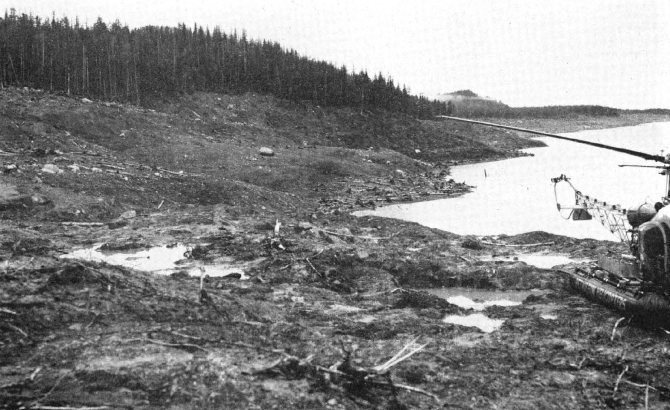
Tsunami in Alaska (1958)
Papua New Guinea (northwest) . In 1988, a landslide occurred, causing 15-meter waves. Several settlements were washed away by the water.
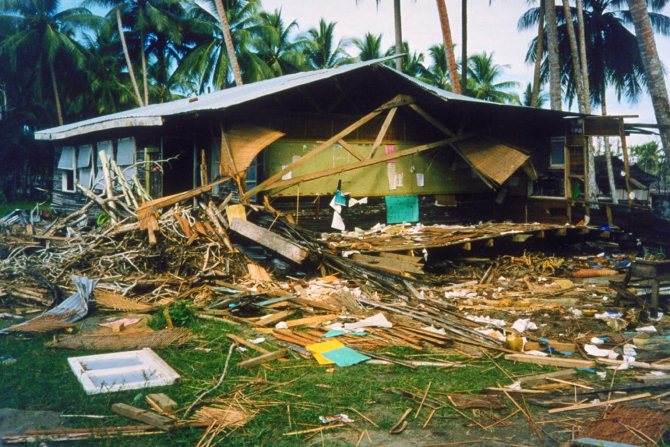
Papua New Guinea Tsunami (1988)
Krakatoa Island . The tsunami was caused by a volcanic eruption in 1883. About 300 settlements were washed away.
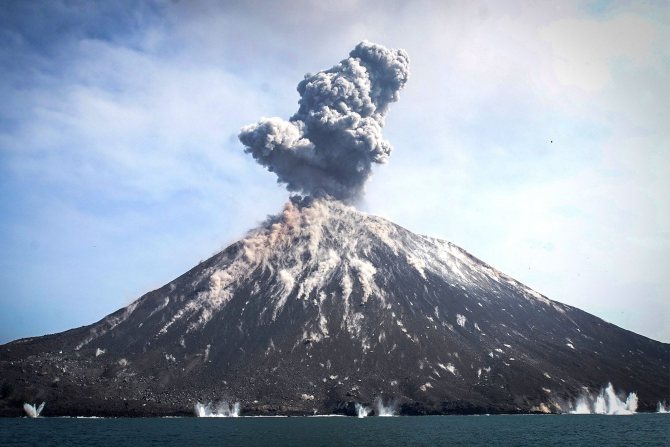
Eruption of Krakatoa volcano
History of major tsunamis
Experts believe that the highest waves are caused by fallen meteorites. The basis for such conclusions was the sudden change in climate at the Pleistocene-Holocene boundary and the fall of celestial bodies into the oceans. But the deadly disasters that have occurred in the world are mainly associated with earthquakes. These include:
- Severo-Kurilsk (Russia). In the early fifties of the 20th century, a strong earthquake occurred near the Kamchatka Peninsula, which formed three waves almost 20 m high. They destroyed the city and several villages at high speed; more than 2 thousand people became victims of the tsunami.
- Alaska (USA). Five years after the events in Kamchatka, Alaska also suffered a strong earthquake, which not only generated two destructive waves, but also awakened the Vsevidov volcano, which had been silent for two hundred years. More than 300 residents died.
- Lituya Bay (Alaska). At the end of the fifties of the 20th century, the largest tsunami in the world occurred here. An earthquake occurred in the north of the bay, which caused powerful landslides. As a result, a wave with a height of more than 500 m was formed, which moved at a speed of 160 km/h and had an intensity of 6 points. Its powerful damaging factors caused damage and destruction at an altitude of up to 525 m above sea level.
- Alaska (USA). In 1964, an earthquake in Prince William Sound generated a series of waves, the maximum height of which reached almost 70 m. The disaster killed 150 people.
- Papua New Guinea. At the end of the 20th century, an earthquake of magnitude 7.1 occurred in the north-west of the island, which created a strong displacement of rock masses along the slope, which generated a tsunami. More than 2 thousand people died in this natural disaster.
- Japan. In 2004, two strong earthquakes were recorded on the Kii Peninsula. As a result, a tsunami was formed with wave heights of up to 1 m. Several dozen people became victims.
- Southeast Asia. At the end of 2004, the deadliest disaster in the Indian Ocean occurred. In a number of countries, a total of 235 thousand people died from the powerful tsunami.
- Solomon islands. After the magnitude 8.0 earthquake, waves several meters high killed more than 50 people.
The last natural disaster in the 21st century occurred on the island of Honshu (Japan). The epicenter of the earthquake was located 32 km east of the island. The resulting waves reached up to 40 m in height.
A natural disaster caused an accident at a nuclear power plant in Fukushima. Officially, about 15 thousand people became victims of the disaster, in addition, more than 7 thousand are listed as missing.
